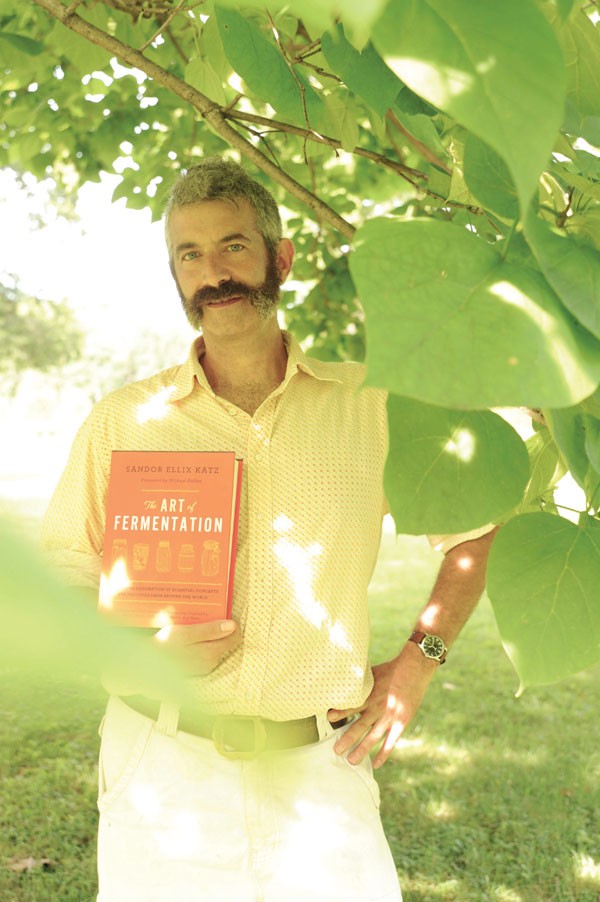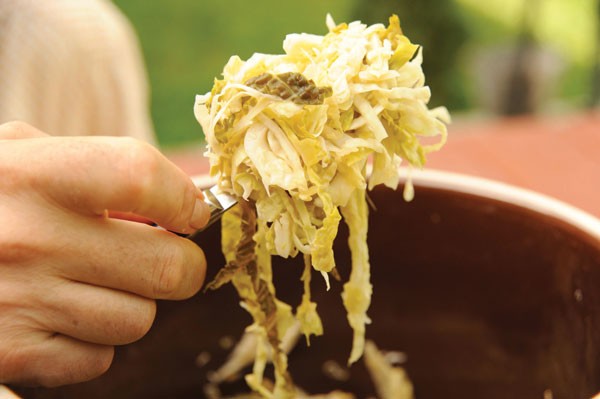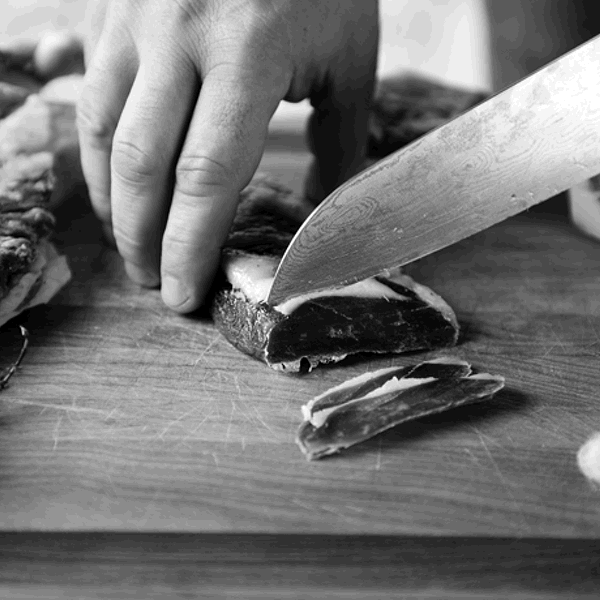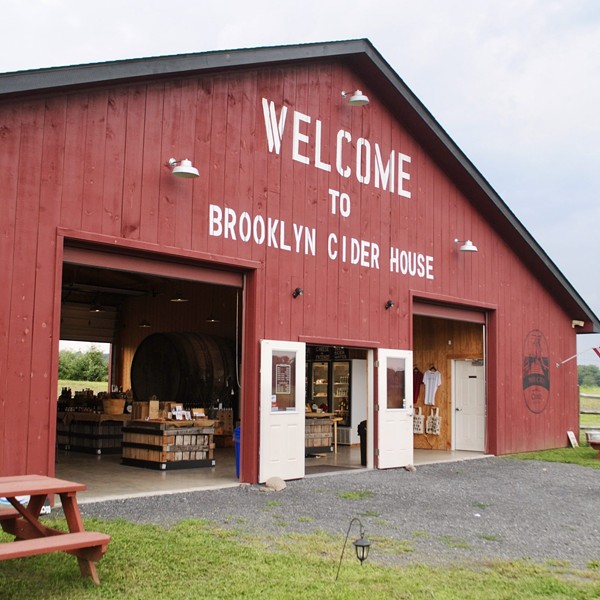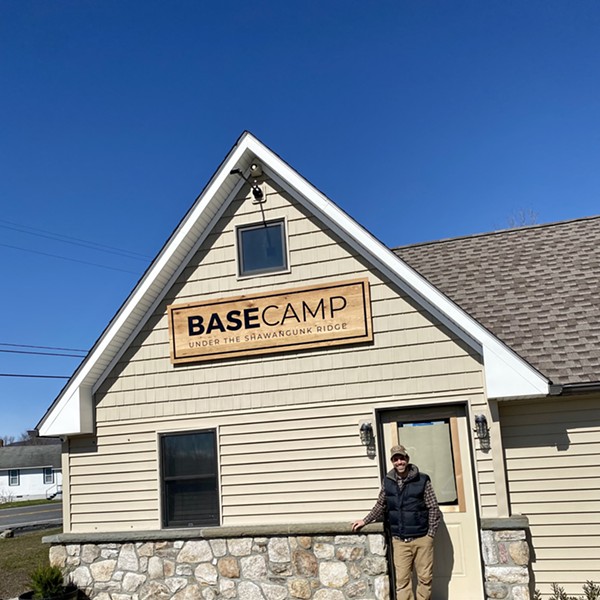The Fermentalist
Sandor Katz
[]
The vast majority of the cells in our bodies are not our own. The Human Microbiome Project has recently determined that our cells may be outnumbered as much as ten to one by hundreds of types of bacteria and other microorganisms that evolved along with us. The complex roles these play are only beginning to be understood, but we could not survive without them; everything from digestion to reproduction to protein synthesis and proper immune function rely on these teeming populations. Bacteria in our guts even regulate serotonin levels in our brains, influencing our moods and mental health.
So why are we taught to fear bacteria? Teaching people to embrace microbes in their food is Sandor Katz’s mission, and his new book The Art of Fermentation (Chelsea Green, 2012) is the definitive book on the subject. The follow-up to his 2003 Wild Fermentation, the new book goes in depth into every aspect and type of food that is metabolized by microbes in some way before we eat it. “We have become used to purchasing these foods already prepared for us,” he explains. “Most of what I do is demystification so people can do it themselves without fear.”
Besides health food and ethnic staples like kombucha, kimchi, miso, tempeh, and soy sauce (among many others), bread, cheese, yogurt, salami, and vinegar are also all fermented foods. By the time we get to alcohol, coffee, tea, chocolate, and vanilla, it’s pretty obvious that most of the best foods are fermented in one way or another, though many of these are no longer alive when we eat them. The living foods are the ones that Katz concerns himself with, since those are the foods that enrich our system with beneficial biodiversity.
The book is comprehensive, detailed, and a must-have for anybody who ferments food or is keen to try. Divided into chapters based on the category of food to be fermented—vegetables, grains, milk, beverages, etc.—it includes descriptions of the tools, techniques, variations, and possible problems associated with both familiar standards and arcane versions from all corners and cultures of the world. If you have been searching for recipes for Smreka, Kishk, Tesgüino, or Pru, look no further. There’s also a section on non-food fermentation, like fertilizers, dyes, medicines, and fuels. While it is no substitute for an in-depth book on one specific discipline, especially a complicated one like wine or cheese making, it offers all the information required to begin confident exploration of every sort of fermentation.
Katz held a book signing recently at his father’s farm stand in Gardiner. Though he grew up in New York City, Katz spent summers in Gardiner and speaks fondly of his time there. For the last 20 years he has lived in Tennessee, on a commune, though two years ago he moved into his own place down the road to have “more privacy and autonomy.” His own introduction to fermentation came when he moved to the rural commune and began tending the garden. “I became overwhelmed by the fleeting abundance of vegetables, so I opened up The Joy of Cooking and made their sauerkraut.”
Katz speaks the way he writes: warmly, in long and eloquent sentences. Both in prose and in person he has a remarkable ability to make a complex subject simple and approachable. For novices, he recommends kraut or similar pickled vegetables as the easiest entrée into microbe ranching. “According to the USDA, there has never been a single case of food poisoning from fermented vegetables. It’s a strategy for safety.” Even if there are pathogens on the food, he explains, “The indigenous population of lactobacilli will overwhelm incidental contamination and eliminate it.” Since vegetables are already teeming with the desirable species, all we have to do is place them in a favorable environment—wet, saline, with a cool ambient temperature—and their metabolism of sugars in the plants will produce lactic acid, killing the competition and making the food pleasingly pickled. Katz says that now is a particularly good time to begin, since our gardens are full of food and summer’s heat (which can make fermentation happen too quickly) is fading.
For those worried about contamination, or accidentally growing the wrong sorts of microbes, Katz is reassuring: “It’s important to be clean, but sterility is not a big deal, unless you’re trying to propagate a specific culture. How can you sterilize something in your house? Even if you autoclave something, you still put it in your dish rack to dry.” The essence of fermenting foods is to create an environment in which the desired microbes can thrive. And there’s endless room for improvisation, once the basic techniques are mastered: “Tailor it to your own tastes, experiment. Make it fiery hot, or use smoked salt in your pickles. It’s experiential learning; you have to try it yourself. There are no hard and fast answers. Many processes are very temperature-dependent, and there’s a lot of environmental variability.” Unheated basements are an ideal temperature for many fermentation processes, and also have the advantage of using no precious fridge and counter space.
It’s worth noting that many such foods use native bacteria and require no inoculation; besides the lactobacilli on vegetables, natto and tempeh are both fermented using bacillus subtilis, which is found on soybeans, and crème fraîche and sour cream were originally made by leaving raw cream near the stove overnight to ripen the naturally occurring cultures. Sourdough starter uses native yeast populations. Vinegar makes itself; just leave apple cider or wine out on the counter for six months. Other foods require cultures; in the case of yogurt, a spoonful of yogurt from a previous batch (or from the store) is added to milk that has been pasteurized and then cooled to about 110˚F. Then the cultured milk is incubated somewhere warm overnight. Easy household incubators include ovens with pilot lights, insulated thermoses, and heating pads inside foam coolers. For Greek yogurt, the result is strained through cloth to drain off the whey (which is useful in and of itself, like cheese whey, as a cooking liquid or for fermenting other foods). Other things, like cheeses, miso, and beer, require adding specific bacterial, mold, or yeast cultures to achieve predictable and reproducible results.
Besides whey and other byproducts—soy sauce was originally a result of miso making—pickle brines are useful in the kitchen, though Katz does not recommend using them as starters for new batches of pickles. There are actually several different types of bacteria responsible for making kraut or kimchi, and they thrive at different stages of the increasingly acidic environment. By adding mature brine to a fresh batch, you are actually adding the end product, unbalancing the natural order. As with so many of these processes, the best strategy is to let them take care of themselves.
Kombucha, fermented sweet tea that has become popular in recent years, is easy to make (it’s very similar to vinegar) and can be flavored with just about anything. If one adds a bit of fruit juice to a fermented batch and then seals the jar up in the fridge for a few days, the secondary fermentation of the sugar in the juice adds a light effervescence. Katz remembers a version made with turnip juice as being the best he ever tasted. He has no time for faddishness, however: “There’s a huge amount of hype about kombucha, including lots of unsubstantiated health claims. It’s not a panacea. All of these foods that have live bacteria are immune system stimulating and help good digestion.” A recent Spanish study showed that people taking probiotic supplements did not achieve the same diversity of flora in their digestive tracts as people who ate a variety of fermented foods. This validates Katz’s assertion that the best health practice is to feed ourselves and our trillions of helpful passengers by eating and drinking all sorts of live fermented products.
Asked what comes next, Katz replies that he’s taking a break: “I’m still recovering from writing this book. I’m doing some teaching, and I might do a children’s book about bacteria and fermentation.” This would be a good way of teaching the next generation something that most of the current one has forgotten: Most microbes are beneficial, even essential, to our health. “Expose your children to the flavors of fermented foods, and have them help you to do it,” he urges. “So many people have this memory of foods their grandparents used to make, but the knowledge didn’t always get transmitted.” Citing ubiquitous antibacterial soaps as a vivid example of our society’s rampant germophobia, he concludes: “I feel really strongly that we have to change our outlook on bacteria. We can’t afford to think about them as enemies.”







